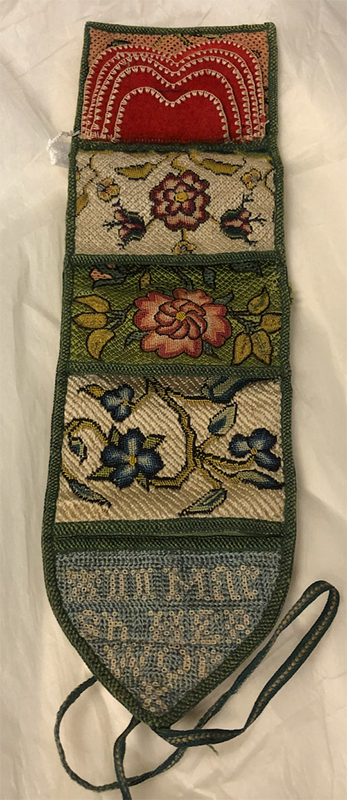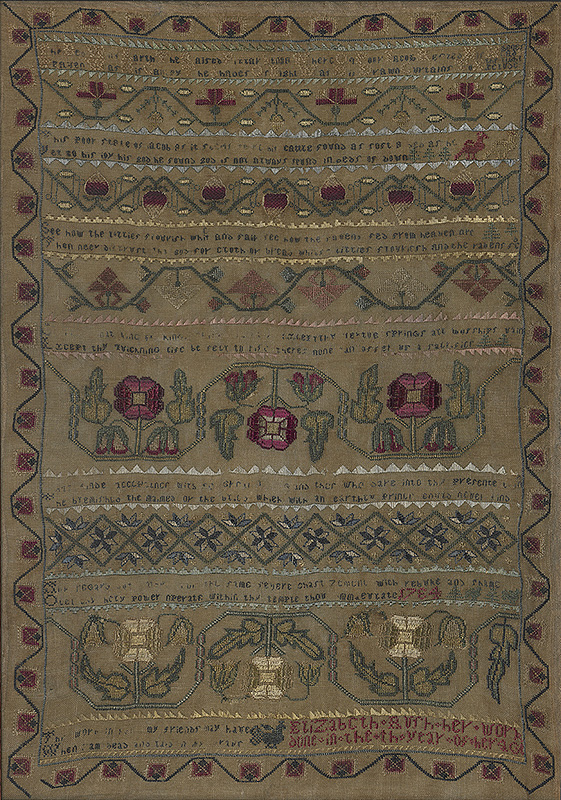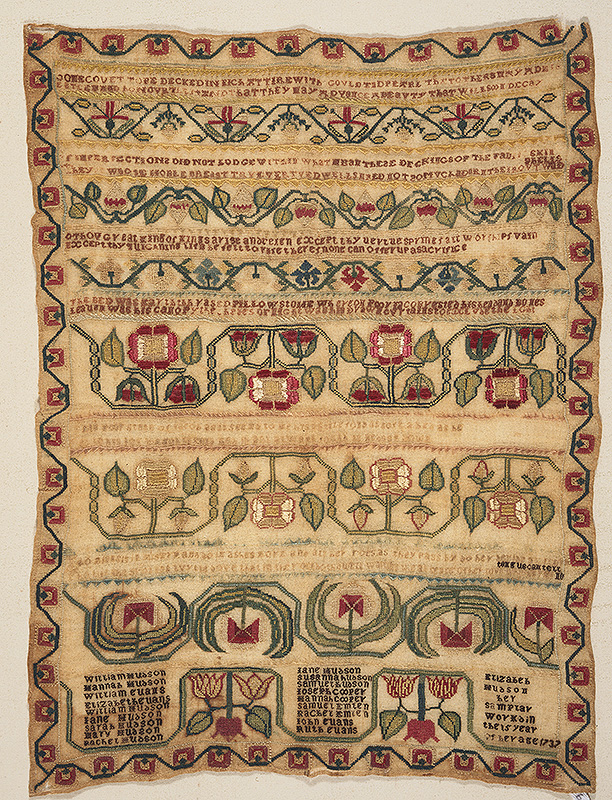Teaching Needlework: Quaker Mother-Daughter Duo Elizabeth and Ann Marsh
by Isabella Rosner
According to Betty Ring, renowned needlework scholar and author of the seminal 1993 book Girlhood Embroidery: American Samplers & Pictorial Needlework, 1650–1850, Elizabeth and Ann Marsh are the most influential needlework teachers in American history. The Quaker mother-daughter duo taught the daughters of elite Quaker and non-Quaker Philadelphia families (and, exceptionally, an unnamed Black boy), establishing a needlework aesthetic popular throughout the Delaware Valley for more than a century.1 Although the Marsh women’s impact on American stitching has been studied, their connection to the London Quaker needlework style that inspired them has not yet been examined. Such an influence can be seen most clearly in the band samplers stitched by Marsh school students between 1725 and 1740.
In Girlhood Embroidery, Ring explains that Elizabeth Marsh was born Elizabeth Allibone in Worcester, England. She married Joseph Marsh, a fellow Worcester Quaker, in 1711 and bore four children. The Marshes immigrated to Philadelphia by 1723, where Elizabeth taught stitching until her death around 1741.2 Ann, the oldest daughter, never married, instead assisting her mother and then running the school from her mother’s death until approximately 1792. Ann moved beyond the band sampler model established by Elizabeth, instructing girls in a variety of embroidery styles. Of the early Marsh samplers, Ring asserts, “their thoroughly English patterns were in keeping with current fashions in London.”3 Her exploration of the Marsh school’s London Quaker origins ends there.
Elizabeth Marsh, or Allibone at that time, was probably educated in London. She is very likely the Elizabeth Allibone who attended a wedding at London’s Westminster Quaker meeting in 1697. She would have been 13 years old. The claim that Elizabeth was educated in London is further buttressed by Ann Marsh’s hussif (figure 1), a narrow, foldable textile used to hold needlework tools. Although Ann made the hussif in Philadelphia in the 1720s or 30s, it looks strikingly similar to two hussifs probably made by Shacklewell students Hannah Downes and Elizabeth Hall in the 1680s or by their daughters in the early 18th century. Shacklewell was the first Quaker girls’ school, established by George Fox (the founder of Quakerism) in 1668 in a village north of the City of London. The similarity in shape, imagery, and stitching between the hussifs suggests that Elizabeth Marsh was taught at Shacklewell or an associated Quaker school in the decade after Hall and Downes and that Ann based her hussif on the one her mother made there.
The samplers made under Elizabeth and Ann’s tutelage also have strong visual similarities to the aesthetically unique samplers created by London Quaker girls in the late 17th and early 18th centuries. Like the samplers worked by Alice and Margrett Jennings in 1692 and 1695 and many others, the Marsh samplers alternate bands of inscription and decoration. Most contemporary, non-Quaker samplers featured text grouped together rather than spread throughout the work.
There are also many similarities in motif between Marsh school and London Quaker samplers. Such convergences can be seen in samplers by Ann Marsh, as well as Sarah Logan, Elizabeth Rush (figure 2), and Elizabeth Hudson (figure 3), all daughters of elite Philadelphia Quaker families. The Hudson and Rush samplers have a band of strawberries also found on samplers made by London Quakers Grace Catlin in 1719 and Dorcas Haynes in 1720. The Haynes sampler also has a band of acorns, similar to those incorporated in the Marsh and Logan samplers and eight-petalled flowers seen on the Logan, Hudson, and Rush samplers. And finally, the Logan sampler is one of several with a verse that reads, “Love the Lord and he will be
a tender father unto thee.” This same verse is present on London Quaker samplers from the 1680s into the 18th century. Elizabeth Marsh was clearly drawing from a large network of Quaker needlework imagery, verse, and compositions.
Elizabeth and Ann Marsh were not particularly upstanding Quakers, as evidenced by their lack of attendance at meetings and Ann Marsh’s choice to write in the normal, non-Quaker style. Despite the Marsh women’s transgressions, the needlework style they promoted was very Quaker indeed. The Marshes provided an education that supported teaching girls the taste and stitching skills that befit a wealthy 18th-century woman, prioritizing refinement over religious beliefs. Surviving 17th-century London Quaker needlework suggests that though stitching such decorative objects was beneficial as it educated girls in the textile trades in which Friends were so heavily involved, it too promoted the nurturing of gentility over adherence to Quaker plainness.
Elizabeth Marsh brought to colonial America decorative needlework designs which appealed to Philadelphia’s Quaker elite and which perhaps established an opulent art style within that community and beyond. This contradiction between Quaker dogma and the art of upstanding Friends is even more jarring when one considers the reformation of the mid-18th century that saw huge portions of the community exiled for not upholding standards and a general move of Quakers away from mainstream society. But, despite massive changes in their religion in the 18th century, Marsh school needlework maintained its lavishness and its strong Quaker origins.
- Ann Marsh’s account book, 1772-1789, Historical Society of Pennsylvania, 17.
- Betty Ring, Girlhood Embroidery: American Samplers & Pictorial Needlework, 1650-1850 (New York: A.A. Knopf, 1993), 332-6.
- Ring, 330.
Isabella Rosner is a PhD Candidate in History at King’s College London. Watch her Virtual Dialogue in The Decorative Arts Trust Bulletin.
A print version of this article was published in The Magazine of the Decorative Arts Trust, one of our most popular member benefits. Join today!



